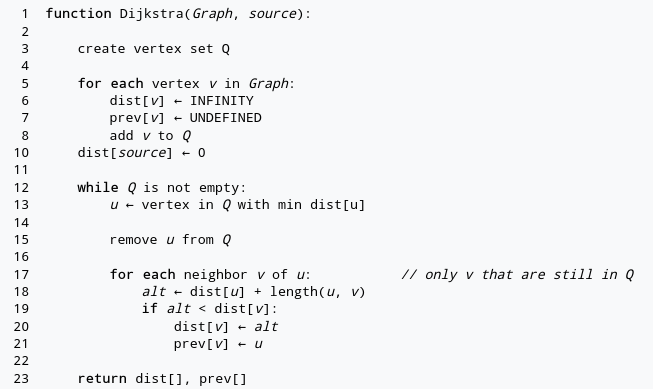This repository contains a performance study over different implementation details of Dijkstra's algorithm. It uses a criterion benchmark to quantify the difference between the implementations.
The code uses OpenStreetMap data to create the underlying graph for the benchmarks. You need to supply an osm.pbf file for example from here. As the benchmark runs many queries and the especially the first implementation is pretty inefficient I would suggest using small graphs such as Isle of Man or the german county Saarland.
If you have the code and a pbf file you can do the following to compile the code and prepare the graph for benchmarking.
cargo build --release
./target/release/prepare_graph path/to/pbf [number of nodes] [seed]This will extract a graph from the file, randomly choose (according to the seed you can optionally pass) a certain number of sources and targets for the benchmark (default 3) and save this in a binary file which is then used by the benchmark.
To run the benchmark for the current implementation use:
cargo benchThis will give you the results of the current implementation and the difference
to the last run of cargo bench.
You can check that the implementations are equivalent via the distances utility of this repo. After compiling you can save the distances (in m) of the source target combinations via:
./target/release/distances > distances.txtIf you switch to another implementation you can use the following to compare the results :
./target/release/distances | diff distances.txt -If there is no output then everything is correct.
All implementations that are suitable for benchmarking are tagged and contained in dijkstra.rs. Please note that the benchmarks only compare Dijkstra's algorithm implementation but the underlying graph data structure is not considered, which plays an important part in the overall performance. This benchmark uses an Adjacency Array Graph as described in Algorithms and data structures: The basic toolbox by Kurt Mehlhorn and Peter Sanders. This data structure is memory and cache efficient and can only be used for static graphs. The performance improvements I state below are of course specific to my hardware as well as the graph and source and target nodes I generated. They always compare to subsequent iterations of the implementation and are only stated for a rough overview. Feel free to open an issue/pull-request if you encounter strong deviation.
If you look at the wikipedia entry on Dijkstra's algorithm the first implementation you find (as of writing this readme) is this:
This implementation uses a set of all undiscovered nodes and a linear sweep over this set in each round of the algorithm. This results in an O(n^2) runtime and is therefore really slow. It can be found under the tag wiki-version. Please note, that the article does also list better versions of the algorithm. I do find it unfortunate to start with a very inefficient one.
Under the tag necessary-nodes-only the code from above is improved to keep only nodes in the set which are on the frontier of the search. Such a node has at least one edge which leads to it processed, but the shortest path distance for it has not yet been settled. This small change leads to about 90% runtime reduction to the previous version.
If you replace the frontier set with a frontier binary heap, you get an implementation with an O(n log n) runtime complexity. That again improved runtime by about 70%. The implementation does not use the decrease key operation of a heap, because it is not present in the heap implementation of the standard library. This is anecdotally faster than using the decrease key operation, but I have not yet benchmarked this. The corresponding tag is heap.
All the previous implementations had been one to all queries. If we stop after the destination node is pulled out of the heap, we do not improve the algorithm asymptotically but have large improvements on "short" queries (as in the distance is smalled compared to the graph diameter). The runtime was reduced between 5% and 90% in my benchmarks for the implementation under tag one-to-one.
In each of the previous versions the distance and previous node vectors as well as the heap/set were allocated for each query. As the vectors need to be #nodes long this can be a substantial amount of allocation time per query. Instead under the tag avoid-reallocation, these data structures are part of the Dijkstra structure and are reset before each queries to their original state. This again benefits "short" queries more than "longer" ones. The improvements range from negligible to 15%.
This last improvement is tagged warm-start. It is based on the observation, that queries from the same start node can reuse the progress already made by the algorithm. This makes subsequent runs with the same start node, either look ups or restarted runs which have to cover less ground. Thereby, this implementation breaks our benchmark and reports 100% performance gain ;).
